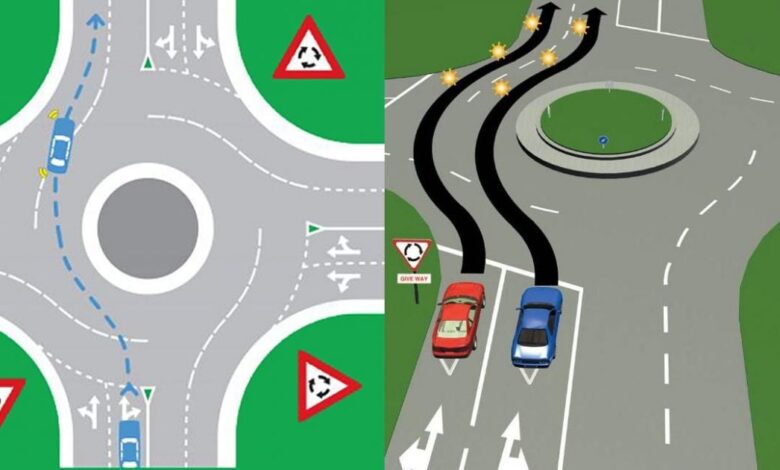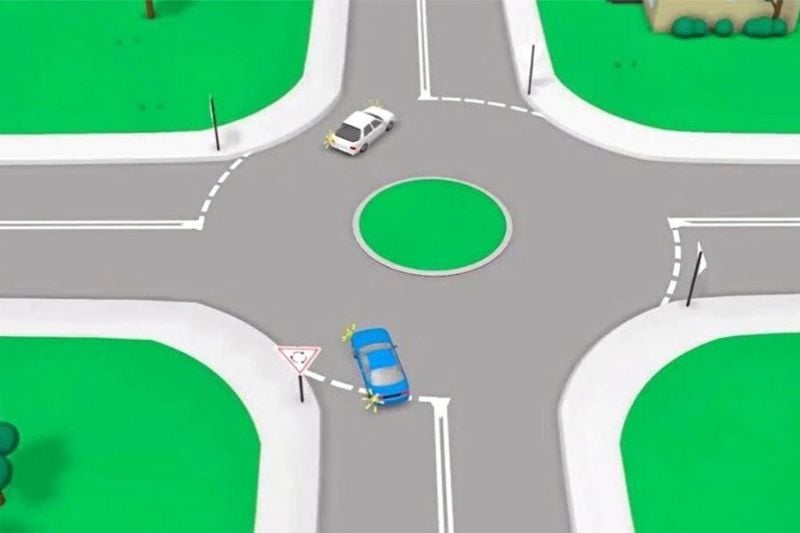Is changing lanes on a roundabout illegal?

Roundabout laws are some of the most confusing in Australia. These traffic circles tend to confuse anyone unfamiliar with driving through or around them, and – anecdotally at least – they are a source of confusion for many motorists.
- You can change lanes in a roundabout, but only in certain circumstances
- It is illegal to cross a solid line – if a roundabout has a solid line, you will be stuck!
- The rules are largely the same in all states and territories
So, what do you do if you’re in a roundabout but need to change lanes because you realize you’re in the wrong lane? Well, treat it like any other multi-lane situation, but remember to check around your vehicle and pay attention to lane markings.
Below is a list of information from each state for this exact situation. Obviously, these mainly apply to multi-lane roundabouts, which often have lane markings to indicate the exact direction in which vehicles should travel. At the same time, in a one-lane traffic circle, you can simply go where you need to go – at least in theory.
The common denominator across jurisdictions seems to be that if a roundabout has solid lines you shouldn’t cross them – just like you wouldn’t cross solid lines on a standard multi-lane road. So if you enter a roundabout and you’re not in the lane you need to be in, and the lane markings are solid, that’s why you’re stuck and need to stay in the intended direction of the lane-marking.
NSW: According to NSW Transport, changing lanes is legal in a roundabout, but the best advice is to “plan ahead when approaching the roundabout to avoid changing lanes while you are in the roundabout”.
However, as the authorities put it: “If you need to change lanes, you must signal and give way to any vehicle in the lane you are traveling in. You can only change lanes where there are broken white lines. You are not allowed to change lanes if the line is not broken. Always remember to check your blind spot when changing lanes.”
Victoria: If you need to change lanes in a roundabout, the same rule applies: let other vehicles know by signaling and yield to any vehicle in the lane you want to enter.
Queensland: QLD has some confusing vocabulary when it comes to roundabouts.
The state tries to point out that comparing roundabouts to clocks can help people understand how to act in said traffic circles:
The turns that occur at roundabouts can be described by imagining the roundabout as a clock face. Any turn off the roundabout before 12 o’clock can be considered a left turn.
Any turn off the roundabout after 12 o’clock can be considered a right turn.
Going straight at the roundabout is counted as going halfway or at 12 o’clock.
The Queensland Road Rules use the terms ‘less than half-way’ and ‘more than half-way’.
Huh?!
Anyway, Noosa Council – which has a roundabout in its neck of the woods – states it simply when changing lanes: “In some cases on multi-lane roundabouts, it may be necessary to change lanes before exiting . If you are changing lanes, you must yield to vehicles moving in the lane in which you are traveling.”
South Australia: SAMove has some interesting articles regarding roundabouts and states that changing lanes in roundabouts is not illegal and is often necessary (the major lanes in Adelaide – Britannia and Blackwood – seem to cause a number of fearful drivers).
Just like other states, it is not illegal to change lanes in a roundabout if you have to, but the following applies:
“The same rules apply when changing lanes on a roundabout as when changing other lanes. You need to show your intentions and give way to vehicles traveling in that lane.”
Tasmania: According to the pamphlet “Tasmania’s 10 most misunderstood traffic rules” from the state’s Road Safety Advisory Council, roundabouts are number one!
However, the document confirms: “Changing lanes within a roundabout – you may change lanes within a roundabout when it is safe to do so. You must signal before changing lanes, and you must also signal before entering and exiting a roundabout.”
Western Australia: WA RAC states: “If you need to change lanes after entering a multi-lane roundabout, wait until it is safe to do so and then signal to change into the correct lane. From there, you must indicate your exit as you would on any roundabout.”
ACT: Canberra is famous for being a city designed with traffic flow in mind, and roundabouts are an important part of the capital’s road layout. As such, there are many different rules for using roundabouts properly, but the ACT follows the same logic as other jurisdictions.
The 2019 Road Rules Manual states: “Sign a change of direction when changing lanes or traffic flow in a roundabout; Drivers driving in a roundabout must: signal a turn to the left before the driver changes the marked lane to the left or enters traffic on the left in the roundabout; signal a turn to the right before the driver changes the marked lane to the right or enters traffic on the right in a roundabout.”
Northern Territory: There are no specific rules regarding lane changes in the Road Rules in the NT document that we could see, but NT guidance states: “It is important to stay in the correct lane at Multi-lane roundabouts – follow signs, lane markings and arrows. Unless traffic lane arrows indicate otherwise, remember these rules:
- To turn left, use the left lane and signal left.
- To turn right, use the right lane and signal right.
- To go straight ahead, use the left or right lane.
- Yield to any vehicle already in the roundabout.
- Signal left when exiting the roundabout.
Not intended as legal advice. Check with the relevant roads authority in your state or territory.






